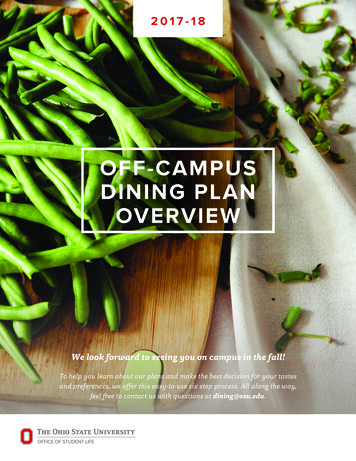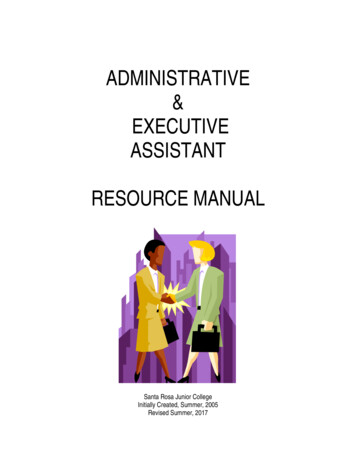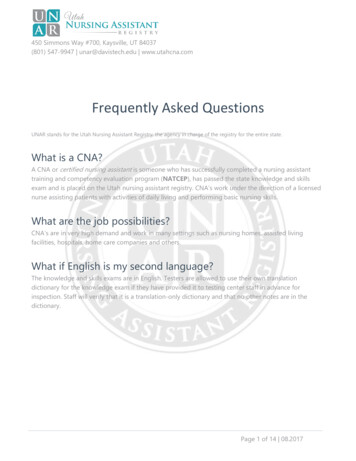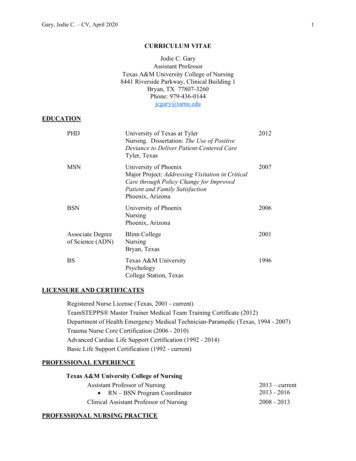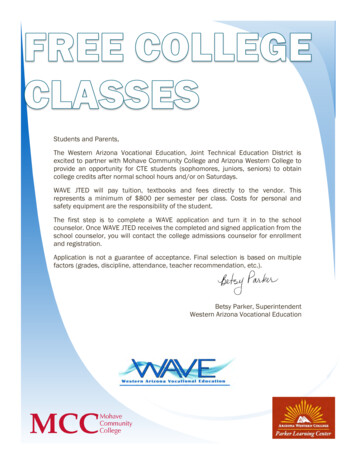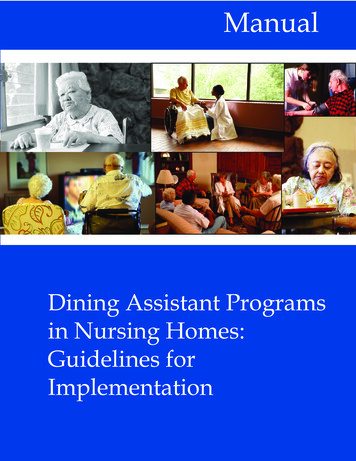
Transcription
ManualDining Assistant Programsin Nursing Homes:Guidelines forImplementation
ContentsChapter One . 1Chapter Two. 3Federal Regulations. 4State Regulations. 5Compliance with State Surveys . 6Chapter Three . 7Models of a Dining Assistant Program. 9Resident and Facility Assessment . 11Chapter Four . 17Immediate Program Goals . 18Long-Term Program Goals . 22Measuring Goal Progress . 25Chapter Five . 27Targeting Recruits. 28Chapter Six. 33Available Training Manuals. 34Training Enhancements . 36Chapter Seven . 41Identifying Residents Appropriate for the Program. 42When to Implement the Program . 44How to Monitor Dining Assistant Care Quality. 45Chapter Eight . 49Appendix . 51Appendix A Dining Assistant Program Worksheets . 53Appendix B Federal Register Notice . 55Appendix C State Contacts . 57Appendix D CMS-Issued Guidance for State Surveyors . 59Appendix E Dining Assistant Observation Tool and Scoring Rules . 61ContentsDining Assistant Programi
Chapter OneIntroductionWhat nursing home administrator or director of nursing has notcringed at the sight of half-eaten trays returned from the dining room,untouched supplements dumped in the trash, and monthly logsshowing unintentional weight loss? Food and issues around diningare usually the top complaint in every nursing home satisfactionsurvey. A Dining Assistant (DA) program that could address andmitigate just a portion of these issues with a minimal investment ofnursing home resources deserves consideration.DA programs are flexible – they can involve only one or tworesidents or only several staff, and be implemented on only one unitor one shift. They can involve community volunteers or paid workers,or in-house non-nursing staff looking for opportunities to advance todirect care work. They can be scaled up or back depending on theneeds of the residents and resources of the nursing home (NH). Ifthe decision is made to train non-nursing staff, the DA program canbe the nursing home’s first step toward culture change.While the Centers for Medicare & Medicaid Services (CMS) and themajority of states now allow the use of dining assistants in long-termcare facilities, relatively few nursing homes have implemented theirown programs. We believe this is due to the limited resourcescurrently available to educate decision-makers on designing andimplementing dining assistant programs and insufficientunderstanding of the advantages to the resident and the NH overallof a Dining Assistant Program.Several stakeholder organizations—e.g., the American Health CareAssociation (AHCA), the American Dietetic Association (ADA), andthe Colorado Department of Public Health and Environment— havedeveloped and published training manuals. These training manualsare discussed in Chapter 6 and provide staff developers withcomplete lesson plans that prepare trainees to safely and effectivelyassist residents during mealtimes. They do not, however, addressthe decision-making process that nursing home management face asthey attempt to determine whether or not a DA Program isappropriate for their NH.Chapter OneDining Assistant Program1
Dining Assistant Programs in Nursing Homes: Guidelines forImplementation is a manual intended to guide management staffthrough a step-by-step process of assessment, goal identification,program design, implementation, and planning for programsustainability. It includes specific guidance to assist managementwith: Assessing their NH in terms of their strengths and weaknessesaround dining quality; Determining if a DA program is an appropriate addition to currentprogramming; Designing a DA program that meets the residents’ needs usingthe NH’s resources; and Successfully implementing a DA program that improvesresidents’ quality of care, residents’ and families’ satisfactionaround dining, and encourages and promotes staff involvementand advancement.In addition to program descriptions and guidance throughout thechapters of the manual, we provide DA Program ImplementationWorksheets (see Appendix A), designed to be copied from themanual and used by nursing home staff developers and others toassess and plan DA programs.Developed by Abt Associates and Vanderbilt University with fundingand input from CMS and the Agency for Healthcare Research andQuality (AHRQ), the manual is the culmination of three years ofresearch that involved an inventory of state programs in all 50 states,site visits to DA programs in several states to observe the programsand interview staff, and implementation of pilot programs in two sitesin two states. The research team consists of experienced long-termcare nurses, nationally- known nutrition experts and a gerontologist,along with CMS and AHRQ staff.The manual is further enhanced by the invaluable contributions ofnursing home staff developers who have implemented DA Programsin their NHs. They generously shared with us lessons learned fromtheir experience with the program, recommended viable options forrecruitment and retention, and offered suggestions on how toimplement an optimal program. Additional contributions to thismanual come from other stakeholder groups such as long-term careaffiliate organizations (e.g., AHCA; American Association of Homesand Services for the Aging (AAHSA)) and the ADA.It is our hope that this manual will encourage nursing homemanagement to consider whether a DA Program could benefit theirNH, as well as provide a valuable resource for developing andinstituting a successful program.Chapter OneDining Assistant Program2
Chapter TwoFederal and State Requirements fora Dining Assistant ProgramIn 2003, CMS published a Federal Register notice allowing long-termfacilities to use Dining Assistants 1 to supplement the services ofcertified nursing assistants (CNAs) during mealtimes (see AppendixB). The legislation had two immediate goals: 1) to increase theavailability of staff during mealtimes, and 2) to provide a set ofminimum training and supervision standards for DA Programs.In addition to the federal regulations, many states have publishedtheir own requirements for DA Programs. Most state requirementsgo beyond those mandated under the federal legislation by requiring,for example, increased DA training and more skilled supervisionduring meals. These federal and state regulations are fundamentalto the DA Program because they provide a minimum set ofcompliance standards.Although instituting a dining program is optional, compliance with thefederal and state-specific regulations is compulsory once NHmanagement have decided to implement a program. Therefore, apreliminary step before considering a DA program is to make sureyour State allows the program and to become familiar with bothfederal requirements and those mandated by your specific State.This chapter presents an overview of the federal regulations, andprovides a guide for locating relevant information on the DA Programin your State.1We have replaced the terminology used in the Federal regulation, “paid feedingassistant,” with the term “dining assistant” to more accurately represent theseworkers who are not necessarily paid or paid beyond their regular salary for thisservice. Further, we believe that the term “dining assistant” is more sensitive toresidents’ sense of dignity.Chapter TwoDining Assistant Program3
Federal RegulationsThe 2003 Federal Register notice includes a list of regulations thatserve as a minimum set of standards for nursing homeadministrators to adhere to when they are interested in trainingindividuals to help feed residents during mealtimes. The FederalRegister notice is printed in its entirety in Appendix B and also canbe found at: http://www.gpoaccess.gov/nara/index.html. Following isa list of the regulations that are included in the Federal Registernotice that should be considered when developing a program: Dining Assistants must complete a state-approved trainingcourse, that includes: A minimum of eight hours of training. Specific Training Topics:– feeding techniques,– assistance with feeding and hydration,– communication and interpersonal skills,– appropriate responses to resident behavior,– safety and emergency procedures including the Heimlichmaneuver,– infection control,– resident rights, and– recognizing changes in residents that are inconsistentwith their normal behavior and the importance ofreporting those changes to the supervisory nurse. State-specific training requirements. Nursing homes must ensure their DA Program meets thefollowing requirements: DAs work under the supervision of an RN or LPN. DAs may not train other feeding assistants. Resident selection must be based on the charge nurse’sassessment, the resident’s latest assessment, and plan ofcare. DAs feed only residents who have no complicated feedingproblems such as difficulty swallowing, recurrent lungaspirations, and tube or parenteral/IV feedings. Management must maintain a record of individuals who havebeen trained and are serving as DAs. The program must follow state-specific programrequirements.Chapter TwoDining Assistant Program4
State RegulationsAs stated above, not all states allow DA programs, so NHmanagement interested in establishing a program should first makesure that it is has been approved by the state. If the program doesnot have state approval it cannot be implemented. If the DAProgram has been approved in the state, it is important to read andunderstand the state-specific requirements. The state of interestmay have a unique approval process and/or require additionalprogram or training requirements beyond those published in theFederal Register notice. Additional state requirements may include: More hours of training than the federally mandated eighthours.More training topics than the federally mandated topics.Competency testing with a skills demonstration, writtenexamination, or a combination of both skills and writtenexam.Training instructor qualifications.State-specific curriculum.Training requirements for Volunteers.Annual in-service for Dining Assistants.To locate information on state requirements, see Appendix C thatprovides state contact information. The appendix, current as ofSeptember 2008, includes web-based links and/or other contactinformation to assist nursing homes to locate state-specific DAProgram regulations.Chapter TwoDining Assistant Program5
Compliance with State SurveysIn 2005, the Abt Associates and Vanderbilt research teamsconducted telephone interviews with state agency representativesengaged in the regulation of long-term care facilities to explore theextent to which NHs across the nation were implementing the DAProgram and to understand the reasons why many NHs had notchosen to implement it. We also visited a small sample of NHs thathad implemented a DA Program.Some NH administrators expressed concerns that the presence ofDAs during a state survey would be a “red flag” and result in greaterscrutiny of nutrition- and dining-related compliance issues. However,a program that is implemented according to federal and stateguidelines should not risk a compliance violation.During the state survey, the objectives of the investigative protocolfor state surveyors are to determine, for a nursing home that usespaid feeding assistants (or DAs): If individuals used as DAs successfully completed a stateapproved training course. If sampled residents who were selected to receive assistancefrom Dining Assistants were assessed by the charge nurse anddetermined to be eligible to receive these services based on thelatest assessment and plan of care. If the DAs are supervised by an RN or LPN.The complete CMS-issued guidance for surveyors in assessingcompliance with the regulations concerning DAs is presented inAppendix D.Chapter TwoDining Assistant Program6
Chapter ThreeDeciding on a Dining AssistantProgram: Program FitF ro m t he F i e ld:Because Joe is available and has beentrained as a Dining Assistant, we areable to bring Mary to the dining roomfor the noon-time meal. Joe isoutgoing and willing to chat with theresidents. Although Mary does notcommunicate well verbally, she smilesand laughs throughout the meal whenshe is assisted by Joe. It has made abig difference in the quality of hermeal-time experience (Staff Developer,Massachusetts, 2008).Note. Names used in these field notes arenot the actual names of the Dining Assistantand resident.The DA Program is a viable solution for increasing staffing duringmealtime.It can serve as a preventive measure againstunintentional weight loss and dehydration, and it can directlycontribute to improving the quality of residents’ lives. This isbecause DAs are likely to have more time to spend interacting withresidents than CNAs who are often pulled away from the dining roomto provide more “hands on” resident care. As a result, DAs are in aposition not only to ensure better nutrition and hydration, but also toengage residents in social interactions and improve the overallquality of their dining experience. Congregate meals are intended toencourage social interaction; yet all too often residents eat mealsisolated in their rooms, or sit alone and disengaged in the diningroom. The use of trained DAs can help to alleviate this problem.Some nursing homes may not need to implement a full DA Programbecause they do not have a history of nutrition problems such asunintentional weight loss and/or dehydration. Other NHs may nothave the physical space or staffing resources to accommodate sucha program. For example, DAs are often recruited from the Laundryand Housekeeping departments. If a NH subcontracts these workersthrough an outside agency, it is unlikely that their contract will allowthem to perform duties beyond those for which they aresubcontracted.Nonetheless, with the exception of unusual cases, some type ormodel of the DA Program will prove beneficial to residents and staffin most NHs. This chapter presents options and assessment ideasfor how to create a facility-specific DA Program.Addressing Concerns about a Dining Assistant ProgramDuring our visits to NHs that have implemented DA programs, weobtained feedback from upper-level staff regarding concerns theymay have had prior to program implementation. In addition to theconcerns about state survey noted above, some staff expressedconcerns about the implications of the DA Program for resident careChapter ThreeDining Assistant Program7
and safety. These included that dining assistant training andsupervision would not be adequate, that assignment of residents todining assistants may not be appropriate (i.e. residents withcomplicated feeding assistance needs such as swallowing difficultieswould be selected), and that training non-nursing staff in diningassistance could increase the likelihood that they will be used toprovide other aspects of daily care (e.g., transferring, toileting,dressing).We understand that many administrators who are contemplating theimplementation of a DA Program may have some of these concerns.However, evidence from early studies indicates these concerns canbe mitigated by a well-designed program that adheres to state andfederal guidelines and incorporates the guidance in this manualwhich was compiled from field experience and input from staffdevelopers who have implemented the program in other NHs.For example, some administrators or other NH management may beconcerned that the minimum federal requirement of eight hours oftraining is not enough. Most of the authors of the published trainingmanuals that we reviewed seem to agree with this concern; thetraining manuals that are referenced in Chapter 6, Training DiningAssistants, present curricula that are longer than the minimum eighthours. Further, Chapter 6 offers some ideas for supplementing thebasic eight hours of training.Proper training will set parameters within which DAs can work. Forexample, they will be taught that they cannot assist residents withdaily living tasks that are unrelated to dining. They will also betrained to recognize and appropriately respond if a resident isobserved having difficulty swallowing. It is very important to alsotrain the nursing staff who will be involved with the program in theproper supervision of DAs, and to require that a supervisor beavailable whenever a DA is assisting residents.Chapter ThreeDining Assistant Program8
Models of a Dining Assistant ProgramAlthough the DA Program has the potential to be beneficial to allresidents and staff, one type or model of program may be moreappropriate than another for a specific NH.Through onsiteobservations during mealtimes, the Abt Associates and VanderbiltUniversity research teams observed several DA Program models. Insome homes, DAs’ roles were restricted to delivering and setting upresident trays, whereas in other NHs they engaged in all mealrelated tasks including physical assistance with eating. By selecting one or some combination of the following mealrelated tasks, a facility-specific model of the DA Program can betailored to meet the dining needs of nearly all NHs: Transport residents to and from the dining room. Deliver and set up trays for residents in the dining room andin their rooms. Circulate around the dining room and in and out of residentrooms to provide social stimulation. Circulate around the dining room and in and out of residentrooms to identify residents who are not eating and to offerthem, and obtain, substitute food items.F ro m t he F i e ld: We have included a hydrationcomponent to the Dining AssistantProgram. I methodically identifyresidents who require regularhydration and assign a DiningAssistant to offer them 8 ounces offluids periodically throughout the day(Staff Developer, Tennessee, 2008).Provide physical guidance to residents in the dining roomand in resident rooms who are able to eat on their own butneed some level of physical guidance (e.g., hand them a forkwith food on it; guide their hand to scoop food). Provide full physical assistance to residents in the diningroom or in resident rooms who are unable to eat on theirown. Offer residents between-meal snacks and fluids.Obviously, not all of the meal-related tasks identified above requireformal DA training. However, participating in the minimal eight hoursof training will prepare entry-level staff and/or volunteers to providebetter service to residents across all of these tasks. Furthermore, itwill prepare staff to engage in more-direct resident care such as fullphysical assistance with eating, if emergency staff shortages occur.In addition, a DA Program can be expanded beyond regularlyscheduled meals to include offering residents additional foods andfluids (snacks, supplements) between meals to increase oral intake.Basic DA Training Programs include modules on communication/interpersonal skills, dealing with resident behaviors, and emergencyprocedures, among others (see Chapter 6, Training DiningAssistants). As an example of how DA training can improve residentChapter ThreeDining Assistant Program9
service, consider a non-nursing, untrained dining room helper whodelivers and sets up trays during the lunch-time meal. This helpermay routinely salt, pepper, and/or sweeten a resident’s food as wellas mix together various food items on the tray without soliciting theresident’s preferences. The skills obtained during DA training willprovide the staff member with information on how to approach theresident, communicate with the resident, and set up the trayaccording to the resident’s preferences.Chapter Three 10Dining Assistant Program
Resident and Facility AssessmentTo implement the best DA Program model for the NH, residents’nutritional status and quality of life should be assessed, as well asNH policies and procedures. Following are quality of care and NHstaffing issues that should be considered when determining theoverall suitability of a DA Program, and used as a guide forconstructing an appropriate facility-specific model for the Program.This section is organized by identification of the issue that may beproblematic for the nursing home, followed by specific guidance forhow to assess and address that issue. Appendix A includes a seriesof six worksheets designed to assist the NH in designing andimplementing a DA program. Worksheet # 1 covers “Conducting theNH Dining Assessment” and may be used to “score” the nursinghome’s dining program.Resident Quality of Care IssuesÆProblem: Unintentional Weight LossOne of the most salient long-term goals that management identify asa reason for implementing a DA Program is to reduce the incidenceof unintentional weight loss. This goal will be expanded upon inChapter 4, Creating Dining Assistant Program Goals, but ismentioned here because it should be used as a primary determiningfactor for whether or not to implement a DA Program. Sources of information from which to determine the prevalenceof residents with unintentional weight loss at your NH include:2 Monthly resident weight documentation. Quality Measure score for significant weight loss for longstay residents. Care plans. Interviews with charge nurses. Interviews with dietary staff. Most recent state survey results to check for nutrition-relateddeficiencies. Minimum Data Set (MDS) item K3a for problematic weightchange (5 percent weight loss in the last 30 days, or 10percent weight loss in the last 180 days). 2All references to the Minimum Data Set (MDS) throughout this Manual are to the 2.0Version.Chapter Three 11Dining Assistant Program
ÆProblem: Poor Meal ConsumptionAlthough poor meal consumption is directly related to unintentionalweight loss, we list it separately because using a DA in a NH thathas a high number of residents with poor meal consumption canpotentially preempt a weight-loss problem.Not eating one’s meal can be caused by a number of issues such as:the food is room temperature when it should be hot (or warm when itshould be cold) and no longer palatable to the resident due to thelength of time it took for the tray to be delivered from the cart to theresident; the food is not palatable to the resident because s/he doesnot receive adequate tray set-up such as adding salt, pepper, andsugar to food and beverages, or cutting up hard-to-eat items; theresident does not like the food that is being served, but is not offereda substitute meal; the resident is a very slow eater but is not givenadequate time to finish the meal; the resident is bored and lonely andlacks the motivation to eat; or the resident requires some level ofphysical assistance, but does not receive it because on occasion thisresident can self-feed. Sources of information from which to determine the prevalenceof residents with poor meal consumption include: Interviews with dietary staff to determine whether or not traysare coming back to the kitchen with uneaten food. CNA documentation of food and fluid intake. Interviews with CNAs to determine if there have beencomplaints about the food. Facility dietary policy regarding when dietary supplementsare routinely administered. Dining room observations. MDS items K4a, K4b, and K4c for complaints about the food,complaints of hunger, and leaving more than 25 percent offood uneaten at most meals, respectively.How a Dining Assistant Program can help: Unintentional weight lossand poor meal consumption can be improved with theimplementation of a DA Program. First, the DA Program placesmore designated staff in the dining room during meals to helpfacilitate tray delivery and set-up. As a result, the food is more likelyto be served at the temperature it was intended. In addition,increased staff availability during mealtimes makes it more likely thatresidents’ preferences will be accommodated. Second, DAs havedesignated time in the dining room so they are more likely to identifyresidents who are not eating and are available to offer and obtainsubstitute food items or provide verbal cueing to encourage mealconsumption. Also, keeping in mind standard infection controlChapter Three 12Dining Assistant Program
procedures, DAs can be seated at a table with one or two residentswho require full physical assistance or physical guidance as they eat.Finally, DAs can help to deliver between- meal foods and fluids anddietary supplements as a way to improve residents’ caloric intake.ÆProblem: Quality of LifeThe clinical impact of residents’ quality of life cannot beunderestimated. Poor quality of life including the perception ofloneliness and isolation can lead to depression and poor nutritionalintake. Research has demonstrated that social stimulation duringmeals can improve the overall quality of life for nursing homeresidents as well as improve their oral intake and nutritional status. 34A positive dining experience that includes social interactionsresults in more food eaten, fewer digestive disturbances, betterabsorption of nutrients, and more positive resident attitudes. 5Competing demands for CNA time both limit the amount of physicalassistance residents receive during meals, as well as the CNA’s timefor social conversations with residents. Further, restricted CNA timeoften impedes their ability to dress and transport all appropriateresidents under their care to the dining room. This leaves manyresidents to eat alone and isolated in their rooms who might havebenefited from the social environment of the dining room. Sources of information from which to determine quality of lifeproblems include: Social Services notes and interviews with social service staffto identify residents with potential problems. Activities notes and interviews with activities staff to identifyresidents with potential problems. MDS Section E1 for indicators of depression, anxiety, andsad mood. Resident observations.How a Dining Assistant Program can help:Fundamentally,implementing a DA Program will increase the number of staffavailable in the dining room and circulating in and out of residentrooms during mealtimes to communicate with residents.Asmentioned previously, a component of the DA training includes a345De Castro JM. Age-related changes in the social, psychological, and temporalinfluences on food intake in free-living, healthy, adult humans. J Gerontol:MEDSCI 2002,57A(6):M368-M377.Simmons SF & Schnelle JF. (2004). Individualized feeding assistance care fornursing home residents: Staffing requirements to implement two interventions.Journal of Gerontology: Medical Sciences, 59A(9):966-973.Morton K. (Ed.). (2003). Eating Matters: A Training Manual for FeedingAssistants. West Hartford, CT: Consultant Dietitians in Health Care Facilities. ADietetic Practice Group of American Dietetic Association.Chapter Three 13Dining Assistant Program
module on resident communication. Staff who participate in a DATraining Program are taught the significance of engaging residents insocial interactions as well as the nuances of communicating withthem. They learn how to approach residents, how to listen toresidents, and how to read resident cues. With the addition of DAsto a nursing home’s staff, CNAs will also have more time available toprovide care and interact with residents during mealtimes. They willalso have more time to groom and dress residents and to encouragethem to eat all three meals in the congregate setting of the diningroom.Nursing Home Staffing IssuesÆAvailability and Appropriateness of StaffF ro m t he F i e ld:At this facility, staff cannot work morethan 40 hours per week and it isdifficult for them to complete theirwork in 40 hours. They are not goingto be willing to give up their lunchtime or work overtime withoutcompensation so that they can assist atmealtimes (Staff Developer,Massachusetts, 2008).Several issues related to nursing home staff can be motivati
the decision is made to train non-nursing staff, the DA program can be the nursing home’s first step toward culture change. While the Centers for Medicare & Medicaid Services (CMS) and the majority of states now allow the use of dining assistants in long-term care facilities, relatively few nu
